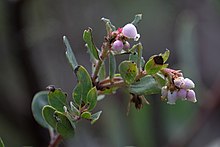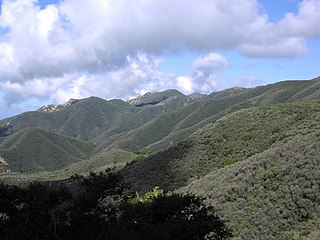
Chaparral is a shrubland plant community found primarily in California, in southern Oregon and in the northern portion of the Baja California Peninsula in Mexico. It is shaped by a Mediterranean climate and infrequent, high-intensity crown fires.
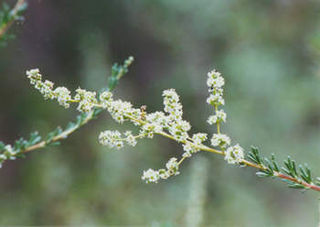
Adenostoma fasciculatum, commonly known as chamise or greasewood, is a flowering plant native to California and Baja California. This shrub is one of the most widespread plants of the California chaparral ecoregion. Chamise produces a specialized lignotuber underground and at the base of the stem, known as a burl, that allow it to resprout after fire has off burned its stems. It is noted for its greasy, resinous foliage, and its status as one of California's most iconic chaparral shrubs.

Frangula californica is a species of flowering plant in the buckthorn family native to western North America. It produces edible fruits and seeds. It is commonly known as California coffeeberry and California buckthorn.

Arctostaphylos auriculata is an endangered species of Arctostaphylos endemic to California, and limited in geography to the area surrounding Mount Diablo, in Contra Costa County.

Eriodictyon altissimum is a rare species of flowering plant in the borage family known by the common name Indian Knob mountainbalm. It is endemic to San Luis Obispo County, California, where it is known from only about six occurrences in the Irish Hills on the coast and nearby Indian Knob.

Ornithostaphylos is a monotypic plant genus which contains the single species Ornithostaphylos oppositifolia, commonly known as the Baja California birdbush or Baja California manzanita. A large, evergreen shrub in the heather family, this species is near-endemic to northwestern Baja California, with a small population just north of the border in San Ysidro, California. It produces a much-branched inflorescence of white, urn-shaped flowers, and has leathery leaves that appear opposite or in whorls. These characteristics separate it from its close relatives in the region, which include manzanitas (Arctostaphylos), summer holly (Comarostaphylis) and mission manzanita (Xylococcus).

Arctostaphylos morroensis is a species of manzanita known by the common name Morro manzanita. This shrub is endemic to San Luis Obispo County, California, where it is known only from the vicinity of Morro Bay.

Arctostaphylos tomentosa is a species of manzanita known by the common name woollyleaf manzanita or woolley manzanita. This shrub is endemic to California.

Arctostaphylos confertiflora is a rare species of manzanita known by the common name Santa Rosa Island manzanita. This shrub is endemic to California, where it grows on the sandstone bluffs of Santa Rosa Island in the Channel Islands. This manzanita is listed as an endangered species by the United States Government.

Arctostaphylos glandulosa, with the common name Eastwood's manzanita, is a species of manzanita.

Arctostaphylos pallida, commonly known as pallid manzanita, Oakland Hills manzanita, and Alameda manzanita, is an upright manzanita shrub from the Ericaceae, or heath family. It is endemic to the eastern San Francisco Bay Area of Northern California.

Arctostaphylos glauca is a species of manzanita known by the common name bigberry manzanita. It is native to California and Baja California, where it grows in the chaparral and woodland of coastal and inland hills.
Arctostaphylos glandulosa subsp. gabrielensis, known by the common name San Gabriel manzanita, is a subspecies of manzanita. It is endemic to one small area in the San Gabriel Mountains of Los Angeles County, California.

Arctostaphylos imbricata is a species of manzanita known by the common name San Bruno Mountain manzanita.

Arctostaphylos montaraensis, known by the common name Montara manzanita, is a species of manzanita in the family Ericaceae.

Arctostaphylos myrtifolia is a rare species of manzanita known by the common name Ione manzanita. It is endemic to the Sierra Nevada foothills of California. It grows in the chaparral and woodland plant community on a distinctive acidic soil series, an oxisol of the Eocene-era Ione Formation, in western Amador and northern Calaveras counties. There are only eleven occurrences, of which three have not been recorded since 1976. This is a federally listed threatened species.
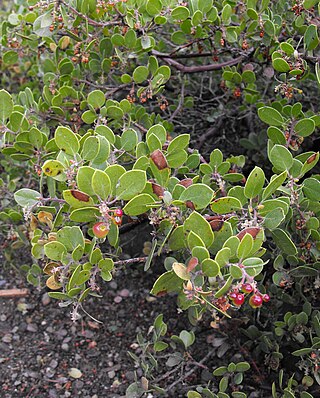
Arctostaphylos rudis, with the common names Shagbark manzanita and Sand mesa manzanita, is a species of manzanita.
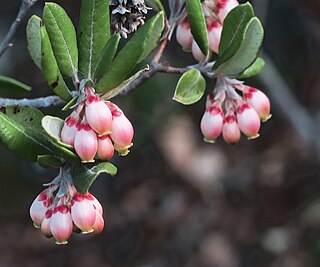
Xylococcus is a monotypic genus of flowering plants in the heather family which contains the single species Xylococcus bicolor, commonly known as the mission manzanita. It is a burl-forming, evergreen shrub with leathery leaves and smooth dark reddish bark. From December to February, white to pink urn-shaped flowers adorn the foliage, often attracting hummingbird pollinators. It is native to southern California and the Baja California Peninsula, south to the Sierra de la Giganta. There is growing concern over the future of this plant, referred to as the "queen of the elfin forest, " as it may possibly lose up to 88% of its habitat and its wild seedlings are failing to survive more than a full year.
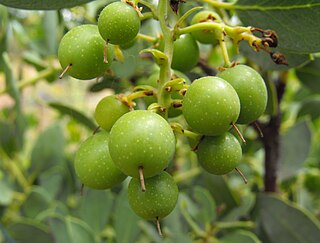
Arctostaphylos rainbowensis is a species of manzanita known by the common name Rainbow manzanita. It is endemic to California, where it is known only from northern San Diego and southern Riverside Counties in the Peninsular Ranges.
Arctostaphylos bolensis is a species of perennial shrub in the heather family commonly known as the Cerro Bola manzanita. This species of manzanita is characterized by an erect habit, pendent panicles and the lack of a burl. It is a prolific bloomer, and when in blossom, it is enshrouded in white to pink urn-shaped flowers. This species is endemic to the Cerro Bola, and possibly the Cerro Italia, two mountain ranges southwest of the Valle de Las Palmas in northern Baja California.
